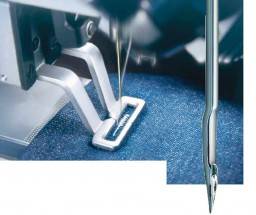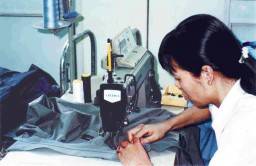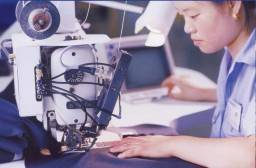
“Your sewing machine is only as good or as bad as the needle being used” … This claim by one of the leading needle manufacturers is more than true. By not using a needle that couples well with your gauge parts or material, you can damage your bobbin hook, throw off the machine’s timing, get puckered seams, break or shred thread, punch holes in your fabric, and at the very least, produce an inferior stitch. Many of the rejections and reworks find their reason in the ignorance regarding sewing needles.
Today, options from a wide variety of needle types exist by varying parameters of shank, shaft, blade, groove, point, eye, and material composition. And with each passing day, these choices and the technology involved are getting more and more complex in their quest for trouble-free sewing. In the article that follows, Niki Tait and Team StitchWorld looks at recent developments in needle manufacturing from leaders around the world – Groz-Beckert, Schmetz, Dotec and Organ.
[bleft] High penetration forces can lead to skipped stitches, point and material damage; thread splicing, thread breaking and needle breakage [/bleft]
With the advent of technical textiles that require a varied combination of different materials and are frequently coated or bonded with foam material, the requirement for durable and accurate seams has placed high demands on the sewing machine needle. Keeping pace with the challenges Groz Beckert SAN 5 needle was developed to eliminate the known application problems related to the processing of such materials, namely needle deflection, stitch hole sticking and irregular seam appearance.
High penetration forces can lead to skipped stitches, point and material damage; thread splicing, thread breaking and needle breakage. The special design of the entire working area of the SAN 5 needle results in a higher bending resistance, in comparison to a standard needle. Needle deviation requires approximately 25% higher force than with standard needles.
[bleft] Groz Beckert’s Gebedur needle is an extremely hard yet highly elastic needle with Titanium Nitride coating and superior hardness of 2300-2800 Vickers Schmetz has developed the DBxK5 FHS needle allowing innovative embroidery techniques without readjusting the hook [/bleft]
The Groz Beckert standard RG point results in less material damage and high process security. The deep scarf and a special eye design guarantee a greater space between the thread and the needle even with a poorly formed loop, and thus fewer skipped stitches and less thread breakage.
Certain synthetic materials tend to melt and stick to the needle during the sewing process. The melted particles are pulled through the stitch hole by the needle and remain on the surface of the stitch hole, and on the thread. The consequence is a less attractive seam. The specially adapted blade geometry of the SAN 5 needle greatly reduces this problem and provides improved stitch hole openings in the fabric resulting in a well balanced pulling in of the thread, regular stitch pattern and improved seam durability.

Another revolutionary development, Groz Beckert’s Gebedur needle is an extremely hard yet highly elastic needle, golden in colour from point to the shoulder due to Titanium Nitride coating. Ever since its launch in 1993, Gebedur became a regular part of Groz Beckert’s product range and many of its special application needles, for e.g. SAN 6 range are also being supplied now only in Gebedur.
Gebedur has superior hardness of 2300-2800 Vickers compared to approximately 800 Vickers of chrome-plated needle. Thus penetrates multiple layers of dense fabrics with ease and withstands far more looper contacts without being worn out.

Gebeduer withstands oscillation and vibration forces during fabric penetration much better at high-speed sewing. It breaks into 2 parts in 97% of the cases (unlike shattering into numerous pieces in chrome plated needles) thus eliminating chances of needle contamination of garments and relatively less machine downtime. This advantage is extremely important in the scenario where needle register is being maintained in the factory.
In tough continuous industrial operations, Gebedur needles demonstrate consistent, optimum functional reliability and a longer needle lifetime (approximately three to five times). This is primarily due to higher wear resistance of needle tip. For the user, this means a reliable, consistently high standard of quality plus maximum economy in every type of production sequence.
To enable extremely different needle sizes within a single embroidery head, thus allowing innovative embroidery techniques without reframing of the material and without readjusting the hook, Schmetz has developed the DBxK5 FHS needle. One hook setting fits all needle sizes from NM 65/9 to NM 110/18 and no hook re-adjustment is necessary when changing the needle. The distance from hook point to scarf and from needle guard to eye/point area remains the same for all needle sizes. Each needle bar within one head can be equipped with another needle size enabling various embroidery thread sizes, from very fine to extremely coarse to be used in one head.
For embroidery of very small sequins with a diameter down to 3 mm and for 3D embroidery, Schmetz has developed the DBxK5 KK SERV 2 with short shank and a flattened shoulder which enables it to cater for extremely elastic materials, embroidery on firm, strong and thick materials, use of very fine to extremely heavy embroidery threads, and very dense embroidery patterns. High quality embroidery processes of this type require the use of special needle geometries. Due to the shank flattening in the shoulder area, the sequin chain cutter can be set very close to the needle without collision of the knife and needle, thus avoiding wear and harm to any of the involved parts.
The round cross-section of the upper shank area means that the needle can be used independently from the position of the needle set screw and there will be no penetration of shoulder or shank into the material, and trapping and breakage of the thread is avoided. The extreme stability in the blade and scarf area minimizes needle breakage. The flat transition between the scarf and blade minimizes the fluttering of the embroidery cloth and reduces the pulling of the material during needle penetration.
Schmetz has also developed the Diamond Carboride needle, a flexible but tough needle, manufactured in an integrated two-stage process. In the first stage, a thin nickel layer is chemically applied to ensure complete protection against corrosion (Nickel offers best corrosion protection amongst all). In the second stage, a Diamond Carboride coating is applied by means of PVD (Plasma Vapour Deposition).
The hardness of the Diamond Carboride layers combined with an oxide ceramic composite of titanium compound imparts great elasticity and ensures that the wear resistance is balanced which protects the entire tribological system in the sewing process, i.e. the material sewn, needle, yarn and sewing machine. Diamond Carboride layers display a high ductility. Although they are not as hard as Titanium Nitride, they display almost double the ratio of elastic to plastic deformation, thus low co-efficient of friction and thus low wear.
Due to the cost involved and problems in technique implementation, most of the surface treatment for sewing needles nowadays is adopted with chrome plating. However, Chromium is very toxic and causes serious environmental pollution. With buyers and consumers becoming more conscious of such issues Dotec, a Taiwanese company, has been exploring more environmental ways to replace chrome plating continuously and has achieved a certain degree of progress. The hardness, wear resistance and corrosion resistance of the new coating will be better than that of chromium plating, while it will cost the same and will not cause environmental pollution.
Organ SK1 series is the latest innovation from Organ Needles, Japan, especially designed to prevent skipped stitches. This innovation surpasses the performance of former designs of crank-from needles. In-house comparisons reveal 30% reduction in the occurrence of skipped stitches. An additional benefit over crank-form needles is the reduction of sewing thread breakage.
Organ also supplies PD (Perfect Durability) Titanium Nitride ceramic-coated needles that are quite similar to the Gebedur needle of Groz Beckert and are specially manufactured either by CVD (Chemical Vapour Deposition) or PVD (Physical Vapour Deposition. The PD needle was introduced by Organ in the market in early 1991.
Processing Technical Textiles
In the clothing and shoe industry, as well as in the processing of technical textiles, an increasing number of computerized multi-directional sewing machines are in operation. The same requirements apply to all these fields of application, i.e. high productivity coupled with maximum process reliability together with flawless, perfect seams with maximum load bearing capacity. With its special blade and scarf geometry, the Groz-Beckert MR needle offers increased bending or deflection resistance. It has an unusually deep and extended scarf that permits extremely tight adjustment of the looper to the needle.
The deep thread groove, extending into the eye area, protects the thread leading to less needle deflection and breakage, fewer skipped stitches and less thread breakage. A bigger cross section at centre eye ensures that its penetration force remains significantly below that of a standard needle. The special asymmetrically shaped thread sliding area inside the eye guarantees stable loop formation eliminating the possibility of negative loop formation and thread twist. Its extreme scarf depth permits very tight looper adjustment, resulting in optimum security during loop pick-up.
While changing needle size from thin to thick, the hook set requires fine adjustment, which results in machine downtime and requires specialized mechanical expertise. GEBEswitch from Groz Beckert is a needle holder that can be fixed in any single needle lockstitch machine, offers unique dial controlled reproducible machine adjustment; quick and easy changing of needles ranging from Nm 80 to Nm 200 in only 10 seconds.

Post a Comment